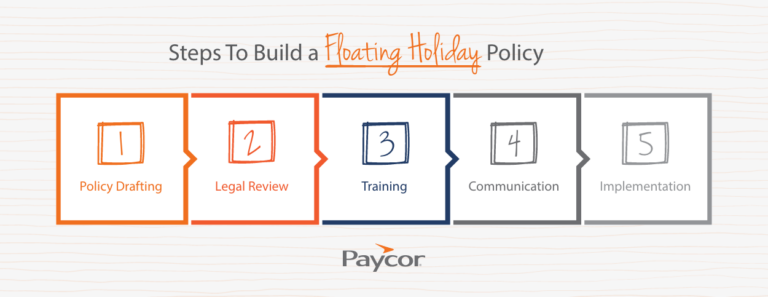Most employers build their holiday schedule in accordance with designated federal holidays, such as New Year’s Day, Veterans Day and Thanksgiving. But as the workforce diversifies and HR departments launch diversity, equity and inclusion (DEI) initiatives, floating holidays provide a good way for benefits leaders to give employees a day off to spend how they would like, whether for religious/cultural observances or a mental health day at home.
While offering a floating holiday is a welcome addition to your employee benefits package, you should understand the concept fully, including its benefits and common rules or restrictions.
What is a Floating Holiday?
A floating holiday is a paid day off that workplaces give their employees in addition to paid public holidays and their PTO accrual. As the name suggests, employees may use this day at their discretion, meaning it can float to any day.
How Does a Floating Holiday Work?
Companies that choose to offer a floating holiday need to clearly define their floating holiday policy, which may differ from employer to employer. Factors to consider include:
- How many floating days to offer
- Eligibility requirements
- Restrictions on usage
Floating holidays are often granted at the beginning of the year or after a certain period of employment. Employees can use their floating holidays at their discretion, provided they follow the company’s request procedures.
What are the Benefits of Offering Floating Holidays?
Implementing a floating holiday offers the following advantages:
- Enhances employee satisfaction: Providing floating holidays allows employees to take time off when they need it most, whether for personal reasons, cultural observances or mental health days. This flexibility leads to higher job satisfaction.
- Promotes inclusion: Floating holidays enable employees to observe their own cultural or religious traditions, aligning with DEI initiatives and supporting a diverse workforce.
- Gives a competitive edge for recruitment: The floating holiday is an underutilized benefit, with more than half of respondents to American Society of Employers’ annual Holiday Schedule & Practices Survey saying they don’t offer it. Providing this benefit could differentiate your company from its competitors.
- Increases productivity: Empowering employees to take time off when they need it helps them return to work refreshed and motivated, which increases productivity and reduces burnout.
And for employees, a floating holiday offers flexibility and autonomy to manage their personal and cultural needs more effectively.
Building a Company Policy + Implementing Floating Holidays
Follow these steps to build a company floating holiday policy.

1. Policy Drafting
First, begin by drafting a policy for how your company plans to handle floating holidays. Consider all the questions employees might have about floating holidays, including:
- How do floating holidays differ from vacation days or paid holidays?
- Can unused floating holidays be rolled into the next year?
- Who is eligible for a floating holiday?
- Are there any restrictions or blackout dates?
- How does an employee request off their chosen floating holiday?
Include the answers to those common questions as well as any rules you want to impose on your floating holiday allowance. Some common rules and restrictions associated with floating holidays include:
- Use it or lose it: Most companies require employees to use floating holidays within the calendar year or forfeit them.
- Advance notice: Employers typically ask for advance notice of an employee’s floating holiday. Two weeks is common.
- Manager approval: While the floating holiday can be taken at the employee’s discretion, it’s still a best practice to require employees to request their floating holiday as they would PTO. This includes submitting the days for manager approval.
2. Legal Review
Once the policy is drafted, run it by legal counsel to ensure it complies with local, state and federal labor laws. Better yet, use a benefits management platform that stays up to date on labor and payroll regulations to ensure compliance. This mitigates potential legal issues and ensures the policy is fair and equitable for all employees.
3. Training
Train HR staff and managers on the new floating holiday policy. Ensure they understand the policy details, including the procedures for approving floating holiday requests and how to communicate the policy to employees.
4. Communication
Next, communicate the policy companywide. Use multiple channels such as email, the company intranet and team meetings to reach employees where they are and inform them of the new benefit. Provide clear instructions on how to request a floating holiday and tell employees where to go if they have any questions.
5. Implementation
Finally, roll out your new benefit at a time that makes sense for your company, whether the start of a calendar year or fiscal year. Update the employee handbook, onboarding paperwork and recruitment materials to include mention of the floating holiday benefit. Also, ensure the infrastructure is in place for employees to request their floating holiday off.
6. Evaluation
As with all benefits, evaluate its effectiveness during your annual benefits review. Keep track of how many employees utilize their floating holiday and solicit feedback from employees, whether they take advantage of the benefit or not.
Review productivity and employee satisfaction metrics to find any changes or patterns correlating with the use of floating holidays. Use the insights gained from this review to make any necessary adjustments to the policy to ensure it continues to meet the needs of the organization and its employees.
How Paycor Helps
From floating holidays to FSAs, a strong benefits package helps employees feel valued. And happy employees are productive employees. Paycor streamlines benefits administration, allowing HR leaders to focus efforts on recruiting and retaining the best talent.
Take a guided tour of Benefits Advisor to learn how Paycor reduces tedious administrative work and maximizes the power of a benefits program.









